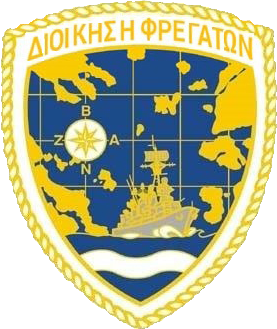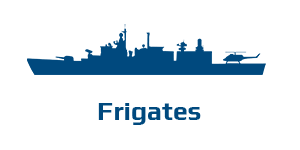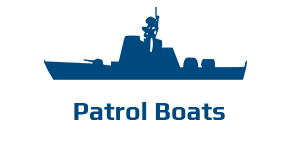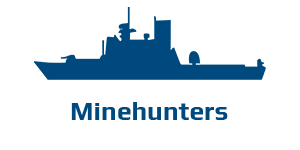HELLENIC
Frigate Command

Crest
The shield depicts a frigate sailing “with an unrestrained speed”, symbolizing the immediacy and the ability of the Command to intervene in all operational challenges. As a background, the North Aegean region is shown, where the Naval Units of the Command contributed to the great successes of the Hellenic Fleet during the Balkan Wars, while the compass card symbolises the high level of Nautical Art possessed by the crews of the Frigate Command.
History
The Frigate Command was actually established shortly before the Balkan Wars in the form of the Destroyer Flotilla and consisted of two (2) Squadrons. The Scout Squadron and the Destroyer Squadron.
During the Balkan Wars, the Destroyer Squadron belonging to the Aegean Fleet, based at Moudros Gulf, Lemnos, contributed to the safe transportation of troops and the control of the Dardanelles, ensuring the Greek maritime control of the Aegean. Noteworthy events include the defeat of the Turkish fleet in the naval battles of ELLI (3 December 1912) and LEMNOS (5 January 1913), as well as the liberation of the islands of the North and Northeast Aegean after successful amphibious operations.
During the First World War, after 1916, the Hellenic Navy conducted naval operations in the Aegean Sea, together with allied nations. These were mainly patrols and convoy escorts.
During the Second World War and in particular during the Greco-Italian conflict of 1940-1941, the Destroyers carried out escort and protection missions in the Ionian Sea and the Otranto Straits, for cargo ships loaded with ammunition, fuel and food for the benefit of the Army. At the same time, offensive operations of limited scale were planned and executed with precision and, above all, without casualties. During the rest of World War II, the six (6) surviving Destroyers that escaped from the German invasion carried out convoy escort missions, port and strait control patrols in the Mediterranean, Atlantic and Indian Ocean. Remarkable are:
- The action of the destroyer B.OLGA, which until her sinking by German bombers at Laki, Leros, on 26 September 1943, had become the first Allied ship of its kind in the Mediterranean Sea, in terms of successes.
- The unprecedented feat of the destroyer ADRIAS which, after having her bow cut off by a mine collision, during a patrol in the Dodecanese in the autumn of 1943, travelled 370 nautical miles in order to enter the Alexandria Naval Station on 23 October 1943.
The largest inter-allied-multinational operations in which Frigate Command’s Naval Units have taken part in the recent past are the following:
- Operation DESERT STORM, for the liberation of Kuwait from illegal Iraqi occupation. Hellenic frigates were patrolling in the Red Sea during 1990-1991.
- Operation SHARP GUARD by which sanctions against former Yugoslavia were implemented.
- Operation ENDURING FREEDOM in order o combat international terrorism in the Persian Gulf in 2002-2003.
- Operation SNMG-2 (formerly STANAVFORMED) were the presence of one (1) naval unit is continouos since 1990 until today, in the framework of the permanently constituted NATO Naval Force operating in the wider Mediterranean region.
- Operation UNIFIL to interdict the trafficking of illicit arms to and from Lebanon, since 2006
- Operation ATALANTA against pirate attacks off Somalia, since 2008.
- Operation IRINI (formerly SOPHIA) to reinforce the UN arms embargo against Libya, since 2015.















